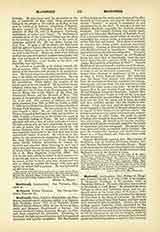

Mabinogion , a collection of medieval Welsh tales in prose. The word is a derivation of mab, “son “, mabinog, “a student in the bardic caste”, mabinogi (pl. mabinogion), “a tale belonging to the mabinog’s repertoire”. The Mabinogion are found in the “Red Book of Hergest”, a large fourteenth-century manuscript kept at Jesus College, Oxford. The stories were probably drawn up in their present shape towards the end of the twelfth century, but the legends themselves are of much greater antiquity, some belonging even to the more distant past of Celtic paganism and to the period of Gaelo-Breton unity. Only four of the tales in the collections are properly called Mabinogion, but the name is commonly given to the others as well. The “Four Branches of the Mabinogi” (i.e. the Mabinogion strictly so called), consisting of “Pwyll”, “Branwen”, “Manawyddan”, and “Math”, belong to the earliest Welsh cycle and have preserved, though in a late and degraded form, a large amount of the mythology of the British Celts. In the “Four Branches” there is no mention of Arthur. Besides these four tales, the Mabinogion includes two from romantic British history, two more interesting ones (“Rhonabwy’s Dream” and “Kulhwch and Olwen”), “Taliesin”, and, finally, three tales: “Owen and Lunet”, “Gereint and Enid”, “Peredur ab Evrawc”, which, though clearly of Anglo-Norman origin and showing a marked kinship with certain medieval French tales, were undoubtedly worked on a Celtic background. It was formerly believed that the Mabinogion were nothing more than children’s stories, but it is now known that they were intended for a. more serious purpose and were written by some professional man of letters, whose name we do not know, who pieced them together out of already existing material. They are admirable examples of story-telling and are of the greatest interest to the student of romantic literature and Celtic mythology.
The Welsh text has been printed in a diplomatic edition, “The Red Book of Hergest”, by J. Rhys and J. Gwenogfryn Evans (Oxford, 1887), also in the three-volume edition (with English translation) by Lady Charlotte Guest (Llandovery, 1849); the translation alone appeared in an edition of 1879. Lady Guest’s translation has been reedited with valuable notes by Alfred Nutt (London, 1902). This is the most convenient translation; the fullest translation is in French by J. Loth, “Cours de litterature celtique”, vols. III and IV (Paris, 1889). The study by I. B. John, “Popular Studies in Mythology, Romance and Folklore”, no. 11, 1901, is an excellent introduction to the subject.
JOSEPH DUNN

